 Overview
Overview
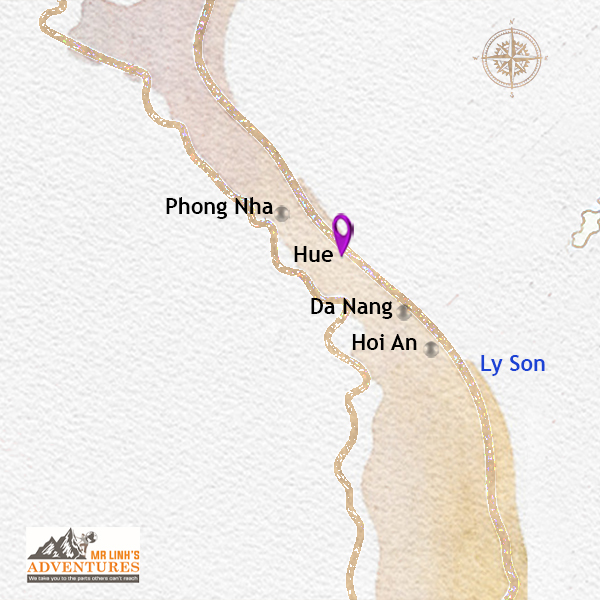 Hue
Hue, the former imperial capital of Vietnam from 1802 to 1945 under the Nguyễn Dynasty, is a city brimming with history and culture, a UNESCO World Heritage Site. Located in the center of the country, on the banks of the Perfume River, Hue offers a captivating journey through majestic citadels, grand imperial tombs, and authentic local life. It's an unmissable destination for travelers seeking discovery, exploration, and adventure.
 Top Attractions
Top Attractions
Hue, the former imperial capital of Vietnam, is a treasure trove of historical and cultural wonders. To truly experience its essence, certain landmarks are simply indispensable.
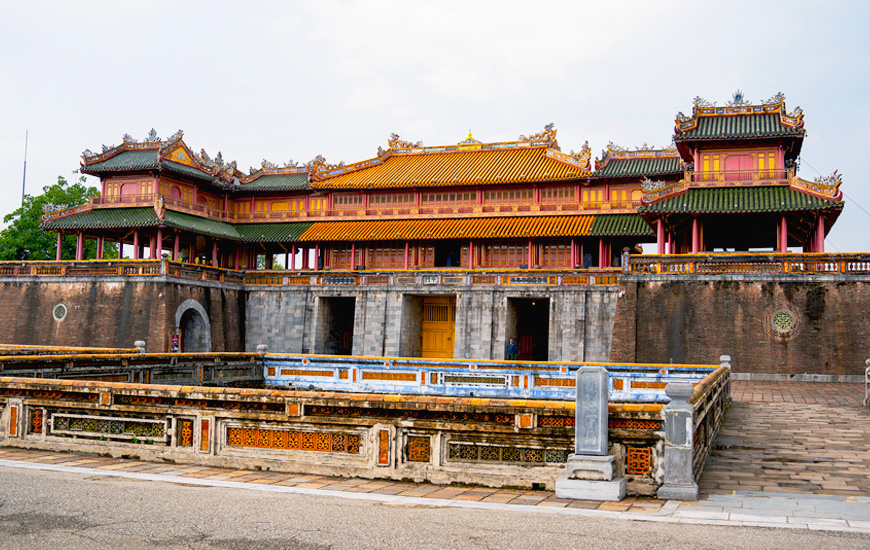 Imperial City in the Citadel - Mr Linh's Adventures
Imperial City in the Citadel - Mr Linh's AdventuresThe Imperial Citadel
At the city's core lies the Imperial Citadel, a sprawling fortress that once served as the political and cultural epicenter of the Nguyễn Dynasty. Within its walls, discover opulent palaces, serene temples, sacred sanctuaries, and the Forbidden Purple City, the emperor's private domain, offering a captivating glimpse into a bygone era of imperial splendor.
 On the grounds of the mausoleum of Khai Dinh - Mr Linh's Adventures
On the grounds of the mausoleum of Khai Dinh - Mr Linh's Adventures The Imperial Tombs
Encircling the city, the majestic Imperial Tombs stand as architectural testaments to the Nguyễn emperors. Each tomb, a unique reflection of its sovereign's personality and aesthetic, graces the surrounding countryside. Notably, the tombs of Tự Đức, Khải Định, and Minh Mạng stand out as exceptional examples of imperial artistry.
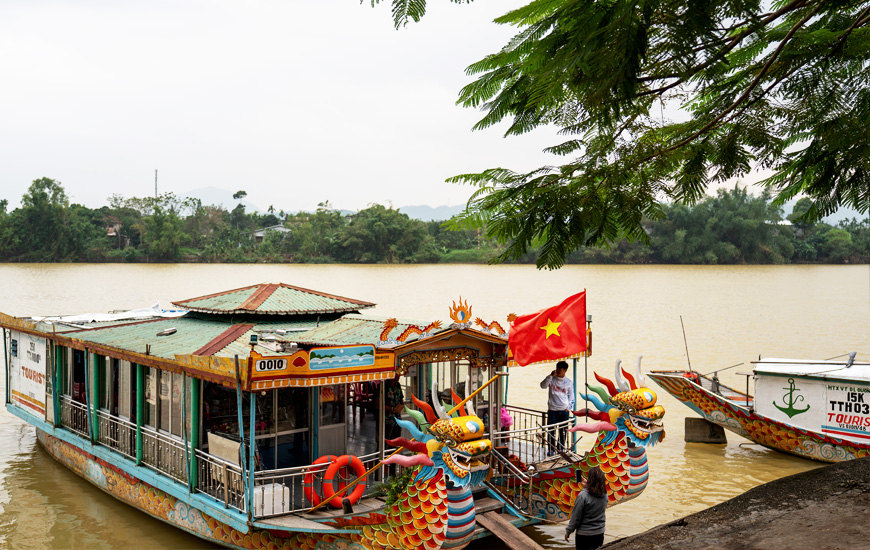 Dragon Boat Cruise on the Perfume River - Mr Linh's Adventures
Dragon Boat Cruise on the Perfume River - Mr Linh's AdventuresThe Perfume River
The tranquil Perfume River, meandering from the Day Truong Son Mountains to Hue, paints a picturesque landscape adorned with ancient tombs, serene pagodas, and lush gardens. Its name, derived from the fragrant orchids that blossom along its banks in autumn, invites exploration by boat or traditional sampan, revealing a captivating panorama that transforms into a magical spectacle under the moonlight.
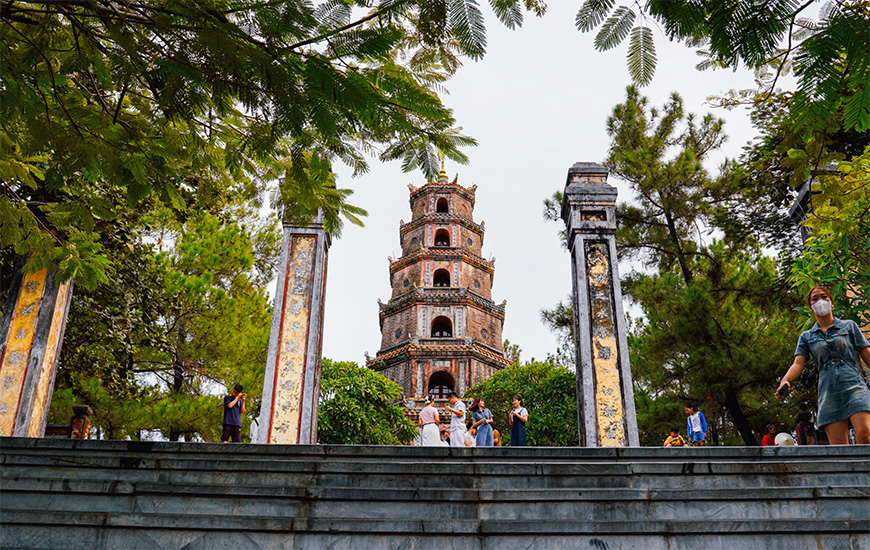 Thien Mu Pagoda, the Pagoda of the Celestial Lady - Mr Linh's Adventures
Thien Mu Pagoda, the Pagoda of the Celestial Lady - Mr Linh's AdventuresThe Thiên Mụ Pagoda
Hue, deeply rooted in Buddhist traditions, beckons visitors to explore its numerous temples and pagodas, sanctuaries of peace and contemplation. The Thiên Mụ Pagoda, the city's oldest, graces the banks of the Perfume River, offering breathtaking panoramic views. Its iconic seven-story octagonal tower rises above a tranquil garden, a serene contrast to the pagoda's pivotal role in the history of Vietnamese Buddhism. The poignant memorial to Thich Quang Duc serves as a powerful reminder of the pagoda's enduring legacy of commitment and resilience.
 See & Do
See & Do
For those seeking adventure beyond the historical landmarks, Hue presents a diverse array of experiences that delve into the region's natural beauty and cultural richness.
 Into the Mist: Hike to Bach Ma's Summit - Mr Linh's Adventures
Into the Mist: Hike to Bach Ma's Summit - Mr Linh's AdventuresCountryside Exploration by Bike or Motorbike
Embark on a journey through the scenic countryside, traversing traditional villages, verdant rice paddies, and the grounds of imperial tombs. Renting a bicycle or motorbike allows for an intimate encounter with local life, fostering connections with residents and revealing hidden gems.
Immersion in Thuy Bieu Village
Discover the tranquility of Thuy Bieu Village, a charming locale renowned for its grapefruit orchards. Immerse yourself in rural Vietnamese life by exploring traditional houses, sampling local delicacies, and participating in authentic cooking classes.
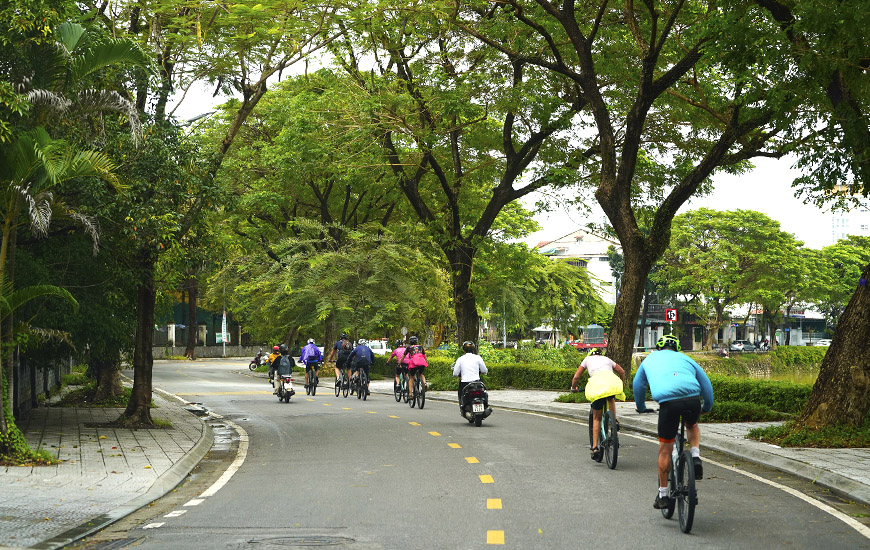 Cycling the Hidden Corners of Hue - Mr Linh's Adventures
Cycling the Hidden Corners of Hue - Mr Linh's AdventuresHiking and Trekking Adventures
Venture into the surrounding hills and forests, where breathtaking landscapes and secluded waterfalls await. The nearby Bach Ma National Park, a haven for nature enthusiasts, offers extensive hiking and trekking trails, leading to cascading waterfalls, lush rainforests, and panoramic vistas.
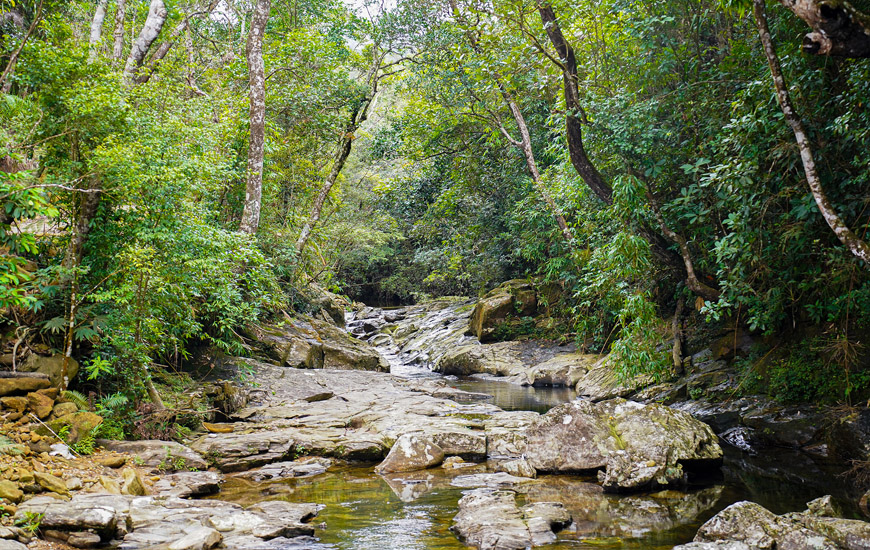 Trekking in Bach Ma National Park - Mr Linh's Adventures
Trekking in Bach Ma National Park - Mr Linh's AdventuresCoastal Relaxation at Lang Co Beach
Escape to the pristine shores of Lang Co Beach, a stretch of white sand fringed by turquoise waters. Indulge in swimming, sunbathing, and savoring fresh seafood at local restaurants. The scenic Hai Van Pass, a renowned route for motorcyclists, provides spectacular views along the journey.
Rejuvenation at My An Hot Springs
Unwind and revitalize at the My An Hot Springs, a natural sanctuary offering a tranquil escape just a short distance from Hue.
Culinary Exploration through Vietnamese Cooking Classes
Delve into the heart of Hue's gastronomy by participating in Vietnamese cooking classes. Learn to prepare the region's distinctive culinary specialties and forge memorable connections with local chefs.
 Go Green
Go Green
Mr Linh's Adventures offers unique and authentic tours in the Hue region, designed for travelers seeking adventure, discovery, and encounters:
Motorbike Tours: Explore the surroundings of Hue by motorbike, taking picturesque roads and discovering places off the beaten track.
Trekking and Hiking: Set off on an adventure in the mountains and forests, accompanied by experienced local guides.
Cultural Experiences: Immerse yourself in the local culture by participating in traditional activities and meeting locals.
Tailor-Made Tours: Mr Linh's Adventures can also create personalized tours according to your desires and interests.
 Heritage
Heritage
Hue, the capital of Vietnam from 1802 to 1945, experienced both grandeur and destruction. Although the scars of conflicts – from the French assault of 1885 to the Tet Offensive in 1968 – are still visible, they cannot eclipse the richness of its cultural heritage. The atmosphere that emanates from Hue today is imbued with a gentle melancholy, sublimated by the Perfume River and the spiritual beauty of its temples and pagodas.
 Điện Thái Hòa aka The Palace of Supreme Harmony is one of the Imperial City buildings - Mr Linh's Adventures
Điện Thái Hòa aka The Palace of Supreme Harmony is one of the Imperial City buildings - Mr Linh's Adventures
Historical Sites
The Imperial Citadel
Dominating the Perfume River, the remains of the Imperial Citadel evoke the splendor of the former royal court of Hue. This complex, protected by a moat, is spread over three enclosures: the Outer Citadel (Kinh Thanh Hue), the Royal Citadel (Hoang Thanh), with its temples and gardens, and the Forbidden Citadel (Tu Cam Thanh), the intimate refuge of the emperor. The Ngo Mon Gate, once reserved for the king, now welcomes visitors.
 Kien Trung Palace is located north of the Forbidden Purple City - Mr Linh's Adventures
Kien Trung Palace is located north of the Forbidden Purple City - Mr Linh's AdventuresThe Imperial Tombs
The royal tombs of Hue, scattered throughout the surrounding countryside, are grandiose funerary monuments built for the emperors of the Nguyễn Dynasty. Each reflects the personality and tastes of its sponsor, offering a fascinating glimpse into Vietnamese history and architecture.
The main tombs, often considered the most impressive, are:
The Tomb of Gia Long: The first emperor of the Nguyễn Dynasty, his tomb is the most remote and the largest. It is distinguished by its harmony with the surrounding nature and its peaceful atmosphere. Less ornate than the others, it favors landscape integration.
The Tomb of Minh Mạng: Considered an architectural masterpiece, this tomb is renowned for its perfect symmetry and majestic style. It embodies the power and rigor of Emperor Minh Mạng. Its gardens, courtyards, and pavilions are arranged according to geomantic principles.
The Tomb of Tự Đức: Undoubtedly the most visited, this tomb reflects the romantic and melancholic temperament of Emperor Tự Đức. It consists of numerous pavilions, a lake, and a theater, creating a harmonious and poetic ensemble. The emperor spent a lot of time there during his lifetime.
The Tomb of Khải Định: The most recent and smallest of the main tombs, it is distinguished by its unique architecture, a blend of Western and Eastern influences. Highly ornate, it makes extensive use of concrete and ceramics, giving it a more modern and opulent look.
 Tomb of Tự Đức who reigned over the Annam empire from 1848 to 1883 - Mr Linh's Adventures
Tomb of Tự Đức who reigned over the Annam empire from 1848 to 1883 - Mr Linh's Adventures
The tombs of lesser importance, often less visited because they are more modest or in a poorer state of preservation, are:
The Tomb of Thiệu Trị: Son of Minh Mạng, his tomb is simpler and less grandiose than that of his father, reflecting his more discreet character. It has similarities with the tomb of Minh Mạng, but in a reduced version.
The Tomb of Dục Đức: This tomb is more modest and less elaborate than the others, partly because Dục Đức had a very short and tumultuous reign. He was deposed and imprisoned shortly after his accession to the throne.
The Tombs of Đồng Khánh and the Following Emperors: These tombs, built at the end of the Nguyễn Dynasty, reflect a growing Western influence and a decline in imperial power. They are often less visited and less well preserved. It should be noted that some emperors do not have attributed tombs, notably the last three (Bảo Đại, Duy Tân and Hàm Nghi), whose destinies were marked by exile and political unrest.
It is important to note that even the tombs considered "of lesser importance" have their own historical and architectural interest. They allow us to understand the evolution of the Nguyễn Dynasty and the changes in tastes and influences over time.
 Emperor Minh Mạng's mausoleum is located on Cam Ke Mountain, 12 km from Huế - Mr Linh's Adventures
Emperor Minh Mạng's mausoleum is located on Cam Ke Mountain, 12 km from Huế - Mr Linh's AdventuresGood to know
Where to Buy Tickets
Directly at the Entrances of the Sites: This is the most common option. You can buy individual tickets at the ticket office of each tomb you wish to visit.
Combined Tickets: To save money and make visits easier, combined tickets are available, allowing access to several sites. These tickets can also be purchased at the entrances of the main sites, such as the Imperial Citadel or the tombs of Minh Mạng, Tự Đức and Khải Định.
Ticket Prices
Please note that prices may vary slightly and it is always best to check the prices displayed on site.
♦ Individual Tickets:
Imperial Citadel: 150,000 VND per adult / 30,000 VND per child (7-12 years old).
Tombs of Minh Mạng, Tự Đức, Khải Định: 100,000 VND per adult / 20,000 VND per child.
Other tombs (Gia Long, Thiệu Trị, Đồng Khánh, Hon Chen Temple): 40,000 VND per adult.
An Dinh Palace, Nam Giao Esplanade: 20,000 VND per adult.
♦ Combined Tickets (valid for 2 or 3 days):
Imperial Citadel + Tombs of Minh Mạng and Khải Định: 420,000 VND per adult / 80,000 VND per child.
Imperial Citadel + Tombs of Minh Mạng, Khải Định, and Tự Đức: 530,000 VND per adult / 100,000 VND per child.
Combined ticket for all sites (including main and secondary sites): 580,000 VND per adult / 110,000 VND per child.
 Wandering the Royal Heart of Hue - Mr Linh's Adventures
Wandering the Royal Heart of Hue - Mr Linh's AdventuresPlaces of Worship and Works of Art
Hue, beyond its citadel and tombs, holds many architectural and spiritual treasures.
Among the most emblematic places of worship, the Thiên Mụ Pagoda, with its octagonal tower overlooking the Perfume River, offers a striking panorama and an atmosphere of serenity. The Hon Chen Temple, dedicated to the goddess Thiên Y A Na, seduces with its colorful architecture and picturesque location. The Tu Dam Pagoda, for its part, testifies to the importance of Buddhism in the city's history. If you feel so inclined, visit the Bao Quoc Pagoda. Perched on Ham Long Hill, it offers a haven of peace where one can observe the fervor and serenity of Buddhist monks. This peaceful place, home to a training monastery since 1935, invites meditation and contemplation.
Thien Mu Pagoda is locatedon Hà Khê hill, three kilometers from Hue citadel - Mr Linh's Adventures
Works of art and public places also contribute to the charm of Hue.
The Trang Tien Bridge, majestically crossing the Perfume River, is a symbol of the city, particularly spectacular at night thanks to its lighting. The Tiger Arena, a vestige of a now-extinct royal tradition, offers a unique testimony to the court's entertainment. Finally, the Nam Giao Esplanade, a place of imperial sacrifices, recalls the rituals and cosmology of ancient Vietnam. These monuments, each in their own way, tell a part of the history and identity of Hue.
Did You Know? The Hue Festival, an unmissable biennial event, showcases Vietnamese culture in all its splendor. Varied and spectacular shows, performed by artists from all over the country, enchant millions of spectators. In April, the whole city comes alive to the rhythm of this exceptional festival.
 Food & Drinks
Food & Drinks
Emblematic Bun Bo Hue - Mr Linh's Adventures
Hue's cuisine is renowned for its finesse and diversity:
Bún bò Huế
Originating from Hue, Bun Bo Hue is an exceptional noodle soup, a legacy of the royal court. Its secret? A subtle balance of sweet, salty, sour, and spicy flavors, enhanced by a rich broth and fresh herbs. A signature dish of Vietnamese gastronomy.
Bánh bèo, bánh nậm, bánh khoái
Steamed or fried rice cakes, colored with turmeric and served with different toppings.
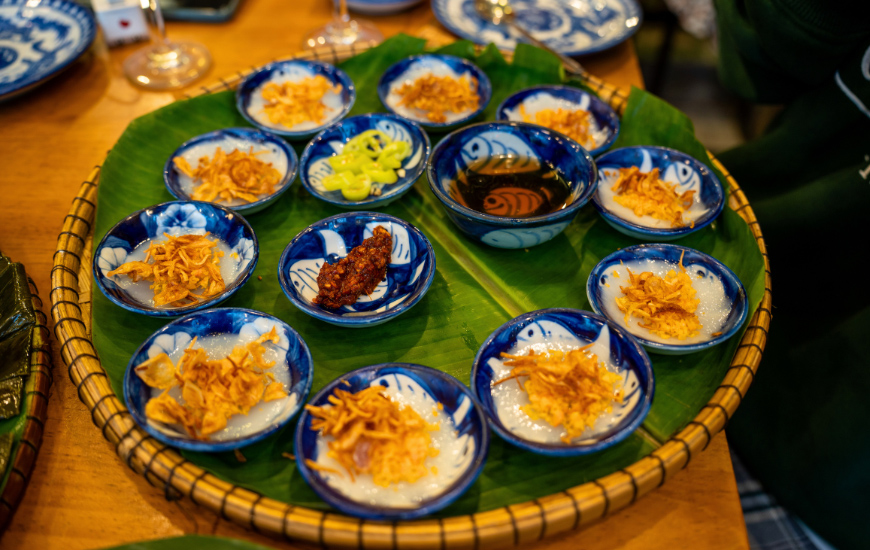 Bánh Bèo: The Soul of Hue Cuisine - Mr Linh's Adventures
Bánh Bèo: The Soul of Hue Cuisine - Mr Linh's AdventuresCơm hến
In Hue, Com Hen is a dish apart. This clam rice, garnished with vegetables and herbs, is served with a spicy broth that awakens the taste buds. A mix of textures and flavors typical of local cuisine, for lovers of strong sensations.
Chè Huế
Sweet desserts made from beans, fruits, and coconut milk.
 Directions
Directions
Location
Hue is located in central Vietnam, about 435 miles south of Hanoi and 685 miles north of Ho Chi Minh City.
How to Get There from Hanoi
✓ Plane: Several daily flights connect Hanoi to Phu Bai Airport (Hue). The flight lasts about 1 hour and 15 minutes. (Price varies, count between $60 and $170 depending on the period and the airline)
✓ Train: The train is a slower but more scenic option. The journey takes about 12 to 14 hours.
✓ Night Bus: Night buses also connect Hanoi to Hue. The journey takes about 12 to 14 hours.
Best Season
The best time to visit Hue is from February to April, when the weather is dry and pleasant. The rainy season runs from August to January.
Hue is a destination that promises an unforgettable adventure, between history, culture, nature, and authentic encounters.
Mr Linh's Adventures is there to accompany you in this discovery, offering unique and memorable experiences.